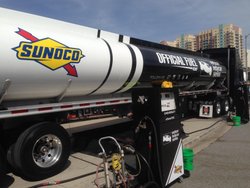F1, IndyCar and NASCAR Lead The Way
Car racing and the environment: an oxymoron? Not so much as you would think. The world of motorsports has a challenging task to reduce racing’s ecological footprint while raising the public’s perception of racing. Therefore, any incremental steps, wherever possible, add-up to significant progress in lessening the environmental impact of car racing.

Motorsports is a $13.5 billion business and the greening-up of auto racing is the newest twist in cars that go fast. Technology advances made in tires, fuels, oils and vehicles (such as electric and hybrid) have already reached the cars we buy at our local dealership. Race teams are staffed with degree-holding engineers, many of whom could have worked in aerospace or other technology fields, but chose motorsports. The result is fast-paced entertainment that also is a leader in environmental awareness.
The top sanctioning bodies of NASCAR, IndyCar and F1 are all getting their green act together. The largest of these in the United States are NASCAR and IndyCar. NASCAR COO Brent Dewar says his program’s green program has made “an industry commitment to demonstrate high-performance racing with reduced emissions.”
Tracks and Teams Join the Green Push
Both organizations encourage tracks and teams to also lessen their environmental footprint. This has resulted in solar panel installation at some tracks. For example, Pocono Raceway in Pennsylvania is 100-percent off the grid. Sonoma Raceway in California uses solar for power, sheep for landscaping, and even has an organic garden for race weekend hospitality. Race teams are onboard using solar and geothermal for heating and cooling, capture and recycle oil, gasoline and water, and employ solar-powered generators to reduce CO2 emissions.

The next extension of the green movement is the cars themselves. Both IndyCar and NASCAR use E85 (85-percent ethanol/15-percent gasoline), which is similar, but a higher octane blend than is available for street cars. Jaye Frye, president of competition and operations at IndyCar, proudly says that they were the “first motorsports series to use a renewable fuel.”
In contrast, F1 cars run on gasoline very similar to what we can buy at the pump. One difference with F1 cars is that their brakes run the Kinetic Energy Recovery System (KERS), which stores energy to drive an electric motor to provide a horsepower boost to the gasoline engine. These hybrid systems are quite complex, but the technology is amazing and related to the hybrids we see on the road everyday.
The Most Innovative Race Series
The most innovative of all race series is Formula E, which campaigns open-wheeled cars like IndyCar and F1, but are powered completely by electricity. Once you get past the sensation of little sound coming from the cars as they whizz by on the track, you begin to appreciate the innovation

and technology taking place with this series. Each of the 10 teams has two drivers, who use two cars in each race. The cars are switched at the midway point of the race as, at least for the 2017 season, the batteries cannot last the entire race at full power. With 0-60 times of three seconds and a top speed of 140 mph, the Formula E cars race within inches of not only each other, but the concrete walls and barriers constructed on temporary city circuits. In the near future, teams will only need one car for a full race as battery technology is quickly catching up to racing.
So, next time you are flipping channels and see car racing, give it a second look. To the non-racing fan, it may seem like an endless and possibly pointless endeavor of driving around and around. Actually, it’s a real-world scientific testing lab right before our eyes where advancements in fuel, engine efficiency, kinetic energy capture and electric motors and batteries are being conducted that will eventually, and in some cases already are, be in the next car you’ll be driving.
Related Stories You Might Enjoy:
Green Motorsports: First EV Finisher for Dakar Rally
Green Motorsports: EV Category Added to All-Women’s Rally
Green Motorsports: A Toyota Prius Racing with a V-8 Engine
News: Toyota Sponsors a Race About Efficiency, not Speed

3 thoughts on “Green Motorsports: Technology Driven Excitement”